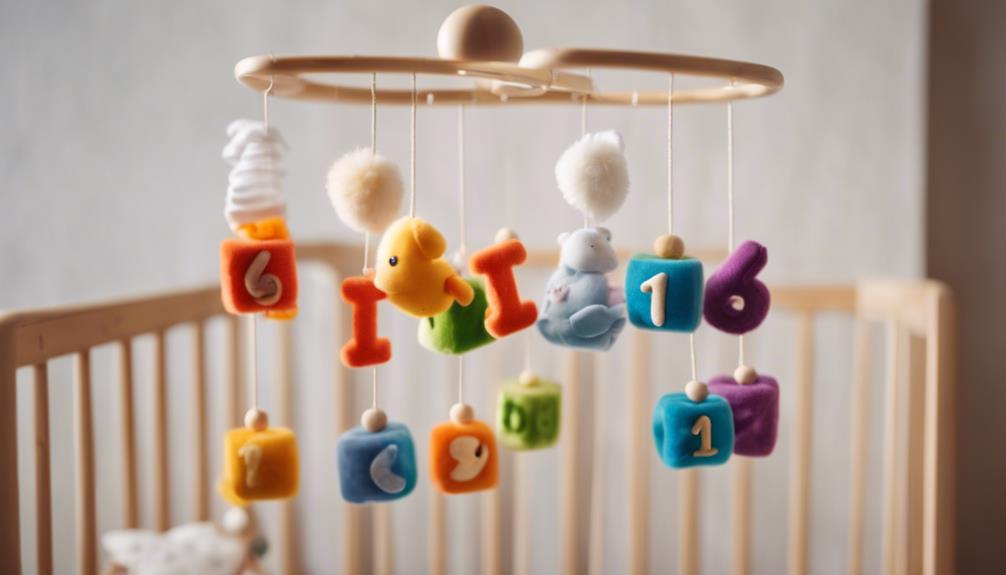By age 2, your child should have a vocabulary of about 50 to 100 words and start combining them into simple sentences. They’ll respond to their name, point to objects, and use gestures like waving or nodding. Watch for signs like limited speech or difficulty imitating sounds, which could suggest a delay. Learning more about supporting their communication can help you encourage healthy speech development—keep exploring these helpful tips.
Key Takeaways
- Most 2-year-olds have a vocabulary of about 50 to 100 words, including familiar objects, people, and actions.
- They begin combining words into simple phrases and sentences to express more complex ideas.
- Early cues include gestures like pointing, waving, and facial expressions, alongside sounds and words.
- Signs of delay include limited speech, not responding to their name, or lack of gestures; early intervention can help.
- Engaging in interactive activities, modeling language, and responding enthusiastically support speech development.
Typical Vocabulary Range for 2-Year-Olds

By the age of two, most toddlers have a vocabulary of about 50 to 100 words. During this stage, you’ll notice rapid vocabulary growth as your child begins to name familiar objects, people, and actions. This period also highlights their increasing language diversity, as they experiment with different sounds and words. It’s normal for some children to have a slightly smaller or larger vocabulary, depending on individual development and exposure to language. You might see them use simple words like “milk,” “dog,” or “more,” and slowly add new words each week. This vocabulary expansion is a key milestone, reflecting their ability to communicate needs and interests more effectively. Additionally, language development milestones can vary widely among children, emphasizing the importance of a supportive environment. Recognizing the importance of early language exposure can significantly influence your child’s communication skills. Providing opportunities for interactive communication with caregivers and peers can further enhance language acquisition. Engaging in consistent talking and reading can also accelerate vocabulary growth and comprehension. Remember, each child develops at their own pace, and variability is perfectly normal.
Combining Words and Simple Sentences
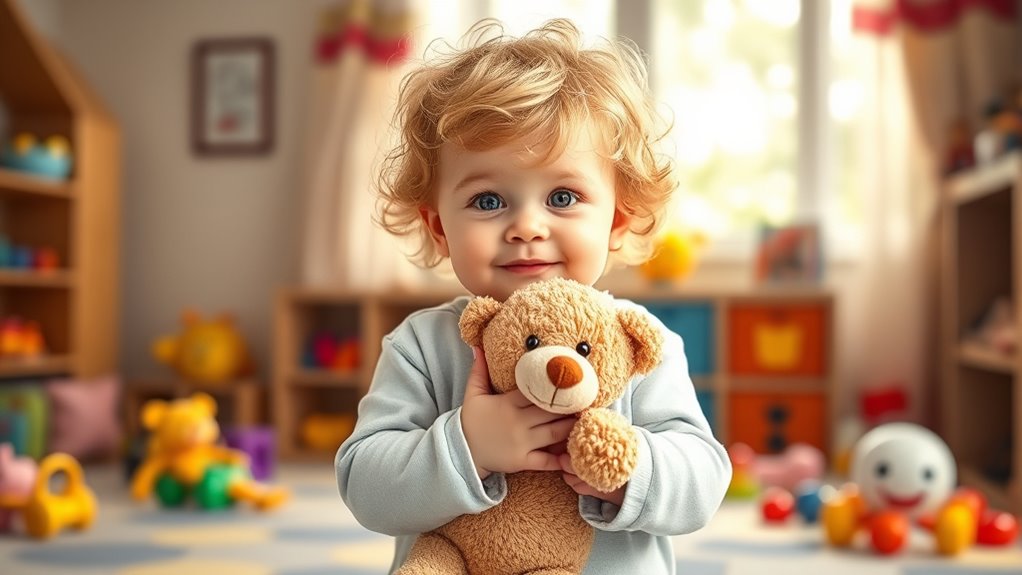
As your toddler’s vocabulary grows, they begin to combine words to express more complex ideas. You can encourage this development through playful language activities and storytelling techniques. These activities help your child practice forming simple sentences and understanding word relationships. For example, you might use the table below to inspire conversation:
| Activity | Example | Benefits |
|---|---|---|
| Naming objects | “Where’s the ball?” | Builds vocabulary |
| Giving commands | “Pick up your toy.” | Improves understanding of actions |
| Asking questions | “Do you want juice?” | Promotes sentence formation |
| Describing actions | “The dog is running.” | Enhances descriptive language |
Engaging in these activities makes learning fun and supports your child’s language growth.
Understanding and Responding to Speech
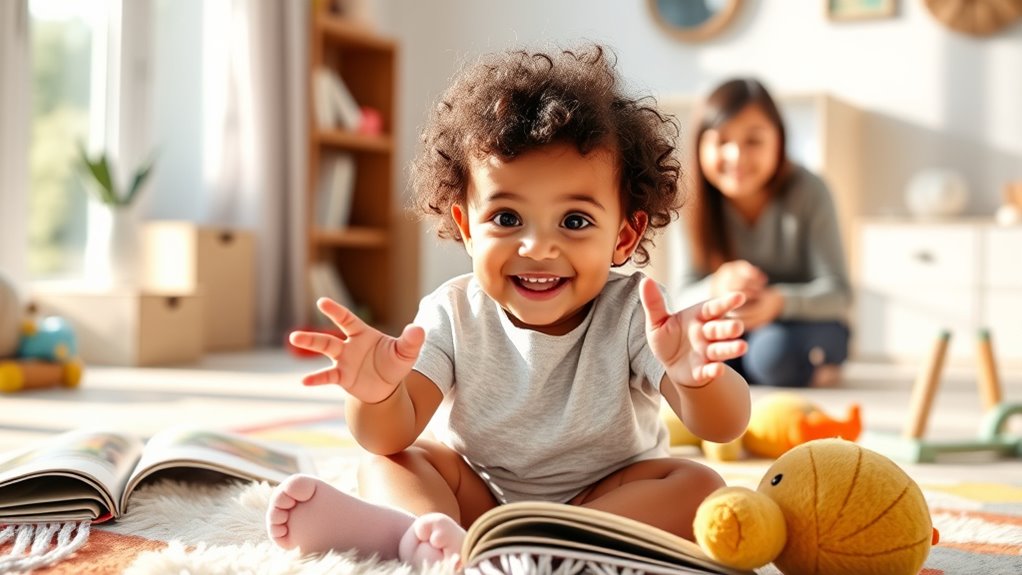
You can support your toddler’s speech growth by recognizing early cues like gestures or sounds that show they’re trying to communicate. When they speak, encourage their language efforts with praise and simple responses. Responding with engagement helps them learn that their words matter and motivates further communication. Additionally, engaging in activities like virtual interactions can foster language development in a supportive environment.
Recognize Early Cues
Recognizing early cues in a toddler’s speech is essential for supporting their language development. Early speech cues include not only sounds and words but also recognizing nonverbal signals like gestures or facial expressions. By paying attention to these cues, you can better understand what your child is communicating and respond appropriately. For example, a toddler pointing or reaching can signal a need or interest. Use this table to identify common early cues and their meanings:
| Cue | Nonverbal Signal | Response |
|---|---|---|
| Pointing | Gesture toward object | Name the object or give it to them |
| Facial expressions | Smiling, frowning | Mirror their emotion, ask questions |
| Vocalizations | Gurgles, babbling | Encourage with praise, repeat sounds |
Recognizing these signals helps you nurture their language skills and build confidence.
Encourage Language Use
How can you effectively encourage your toddler to use language? Engaging in interactive storytelling is a great way to boost their communication skills. Make storytime interactive by asking questions, encouraging them to fill in words, or act out parts. Incorporate play-based language activities, like pretend play or singing songs, to naturally promote speech. Use everyday moments to model proper language, and respond positively when they attempt to communicate. Keep conversations simple and give them time to express themselves without rushing. Your encouragement and involvement reinforce that language is fun and meaningful. Additionally, understanding the importance of visual clarity and color accuracy in supporting effective communication can help create an engaging learning environment. To further support language development, it’s helpful to be aware of developmental milestones and how they guide your expectations. Recognizing the significance of cultural and regional influences can help tailor your approach to your child’s unique background. Being aware of regional legal resources can also help you find local support and guidance. By creating an engaging environment filled with storytelling and playful activities, you help your toddler develop confidence and expand their vocabulary naturally.
Respond With Engagement
Responding with engagement is essential for helping your toddler feel heard and understood. When your child attempts to communicate, acknowledge their efforts with eye contact, smiles, and verbal prompts. Using baby sign language can be a helpful way to bridge understanding if your toddler’s speech is still developing. Always respond enthusiastically to their attempts, which encourages further communication. If you’re concerned about your child’s speech progress, explore speech therapy options early on. Speech therapy can provide strategies to improve their language skills and boost confidence. Remember, your active listening and supportive responses create a positive environment where your toddler feels motivated to develop their communication abilities. Your engagement is a crucial step in nurturing their language journey. Incorporating essential oils for speech development may also support a calming and focused environment that benefits your child’s learning process. Additionally, engaging in activities that promote language-rich interactions can further enhance their communication skills. Creating a supportive learning environment at home can make a significant difference in their development. Recognizing the importance of digital literacy in modern education can also help you incorporate educational technology that reinforces language learning at home. Being mindful of vetted resources and strategies ensures that you are providing your child with safe and effective support for their speech development.
Nonverbal Communication and Gestures
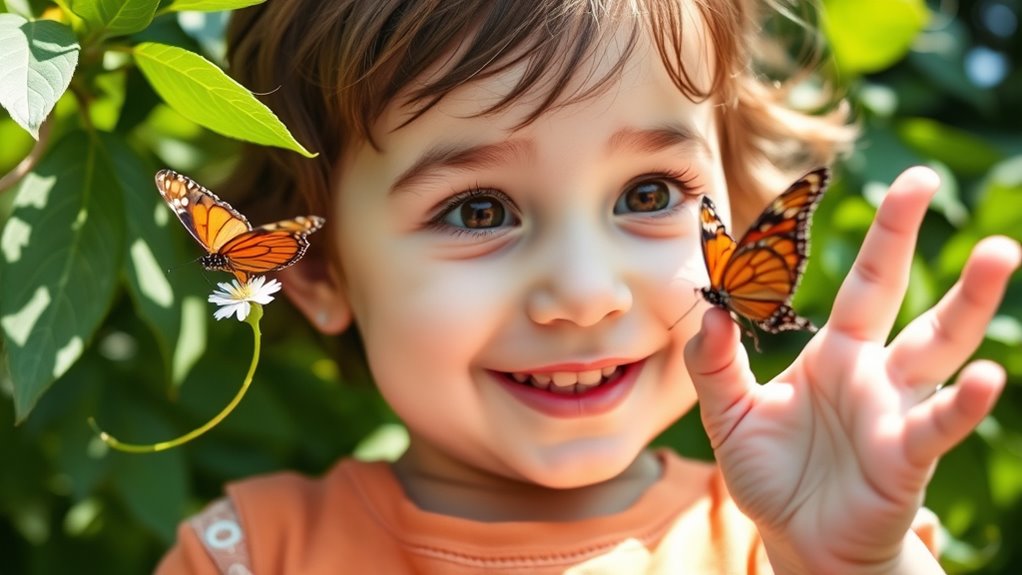
Nonverbal communication and gestures play a crucial role in how toddlers express their needs and emotions before they develop full speech. Through gestural communication, your child uses nonverbal cues to share feelings and desires. Recognizing these signals helps you understand their world better. Watch for these key gestures:
- Pointing — Indicates interest or wants something.
- Waving goodbye — Shows recognition and social connection.
- Nodding or shaking head — Signals yes or no.
- Clapping or reaching out — Expresses excitement or a desire for attention.
These nonverbal cues are essential for early communication. They help your toddler connect with you and others, laying a foundation for verbal language development. Paying attention to these gestures fosters understanding and bonds. Supporting your child’s communication skills through nonverbal cues can boost their confidence and social interactions as they grow. Additionally, understanding early communication milestones can guide you in supporting their development effectively. Recognizing the importance of gestural communication can also help you identify any delays early on and seek appropriate support if needed. Being attentive to nonverbal signals can further enhance your ability to respond appropriately and nurture your child’s expressive skills. Developing awareness of nonverbal communication is key to fostering their overall social and emotional growth.
Signs That May Indicate Delayed Speech Development
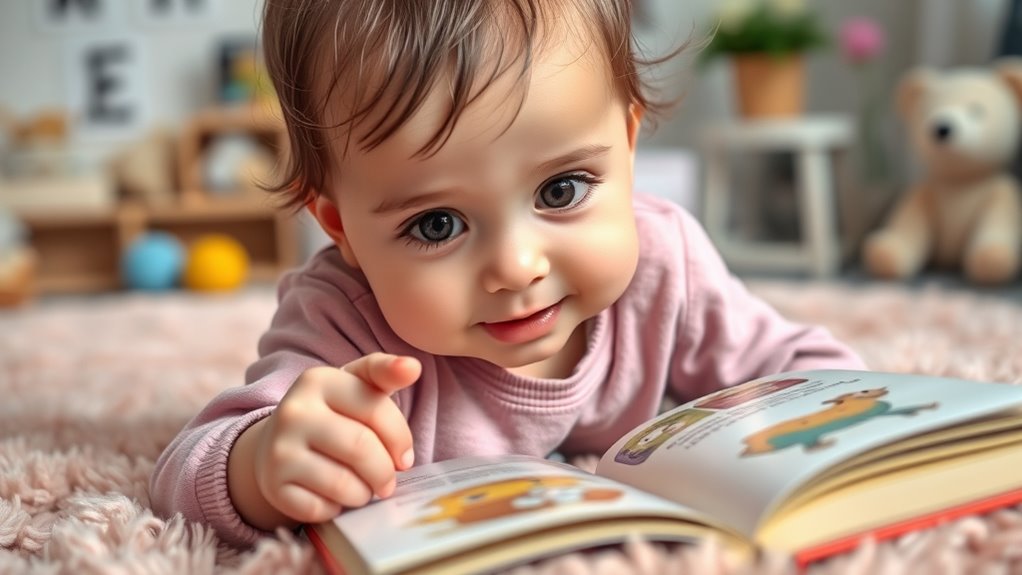
While gestures are early indicators of a child’s ability to communicate, noticing when these signals don’t develop as expected can be important. If your toddler isn’t saying words by age two or isn’t combining words, it might signal early speech delays. Other signs include limited sounds, difficulty imitating speech, or not responding to their name. You may also notice a lack of gestures like pointing or waving. Early intervention can be crucial in addressing these delays and supporting your child’s communication development. These delays can impact social interactions and learning. If you observe these signs, exploring speech therapy options can be helpful. Speech therapy can support your child’s development and help them catch up with their peers. Early intervention is key, so trusting your instincts and consulting a specialist can make a significant difference in your toddler’s communication skills. For example, Vetted options like specialized speech therapy programs can provide targeted support to address these delays effectively.
Tips to Support and Encourage Speech Growth
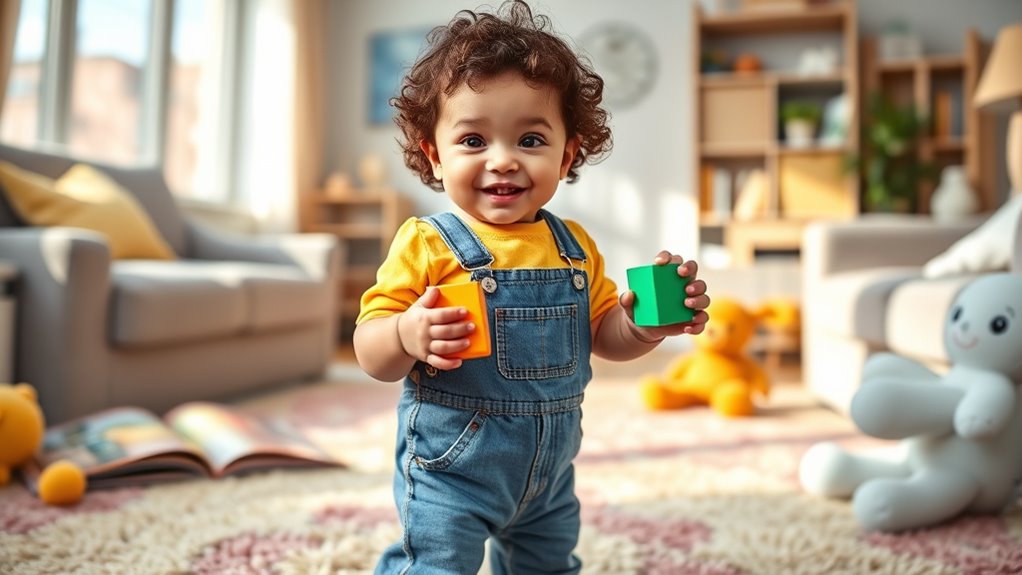
Encouraging your toddler’s speech development can be simple and effective with consistent strategies. Engaging in interactive storytelling captures their imagination while expanding vocabulary and sentence skills. Incorporate musical language activities like singing songs or nursery rhymes to make learning fun and memorable. Here are four tips to support growth:
Support your toddler’s speech growth with engaging storytelling and musical activities for fun, learning, and development.
- Talk often and listen actively—your child learns best when they feel heard and valued.
- Use expressive gestures and facial expressions to reinforce words and emotions.
- Create opportunities for interactive storytelling, encouraging your toddler to participate and predict what happens next.
- Sing songs and incorporate musical language activities to enhance rhythm, pronunciation, and memory.
Frequently Asked Questions
When Should I Be Concerned About My Toddler’S Speech Delay?
If you’re worried about your toddler’s speech delay, trust your instincts and seek early intervention. Usually, you should consult a professional if your child isn’t using simple words by age two or isn’t making eye contact or responding to their name. A developmental screening can help identify issues early on. Addressing concerns promptly can make a big difference, so don’t hesitate to reach out to a specialist for guidance.
How Can I Differentiate Between Normal and Delayed Speech Development?
Did you know that about 1 in 12 children experiences a speech delay? To differentiate normal from delayed speech development, watch for speech delay signs like limited vocabulary or difficulty understanding language comprehension. If your toddler isn’t combining words by age two or shows signs of frustration, it might be worth consulting a specialist. Remember, every child develops at their own pace, but early intervention can make a big difference.
Are There Specific Activities to Promote Language Skills in Toddlers?
You can boost your toddler’s language skills with fun activities like storytelling games and singing nursery rhymes. Engage them in simple stories, ask questions, and encourage them to repeat words. Singing nursery rhymes helps with rhythm and pronunciation. These activities make learning enjoyable and support vocabulary growth, helping your toddler develop speech naturally. Consistent practice and positive interaction are key to nurturing their language development.
What Role Do Caregivers and Teachers Play in Speech Development?
You play a crucial role in your child’s speech development by engaging in interactive reading and expressive play. These activities encourage your toddler to imitate sounds, expand vocabulary, and build confidence in communication. By actively participating, you create a supportive environment where your child feels motivated to express themselves. Your involvement helps foster language skills, making learning fun and effective during these formative years.
When Should I Consider Consulting a Speech-Language Pathologist?
When you notice your child’s speech isn’t developing as expected, you should consider consulting a speech-language pathologist. Early intervention is key, so don’t wait if your child’s language skills seem delayed or they struggle to communicate. A professional can conduct a thorough language assessment to identify any issues and provide targeted support. Addressing concerns early helps improve your child’s communication skills and boosts their confidence for the future.
Conclusion
By understanding your 2-year-old’s speech skills, you can confidently support their speech, social, and sensory growth. Remember, patience and praise pave the path to progress. Stay attentive to their words, wishes, and whims, and watch their wonder and words widen. With consistent care, communication, and encouragement, you’ll nurture their nascent language skills, helping them thrive and talk their way into a world of wonder. Your guidance makes a meaningful, memorable difference.




